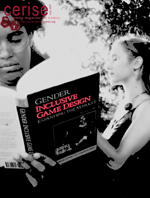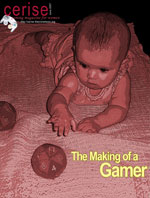tekanji's blog
Cerise: July 2007 and Call for Submissions
Submitted by tekanji on July 6, 2007 - 3:07am. News
The July 2007 issue is out! The theme is "Inclusive Game Design", and we have some great stories in our new feature "gamer stories" relating to that.
We're currently looking for submissions for our August issue. Here's the call for submissions:
Submission deadline: July 20, 2007
Theme: The Social GamerWomen gamers are often dismissed as “casual” or “just social” gamers, regardless of the hours they put into play or the attitude with which they approach their games. Of course, the reality is that the vast majority of games are social, in one way or another. Many require social interaction of some kind in order to be played at all, and even games which are designed exclusively for single players have their social components ? bragging about high scores, anyone?
What are some of the social communities and structures that surround games, both online and off, and how do they intersect and interact? What role do they play in the gaming experience? Is it important to have membership in more than one community? Are “special interest” communities necessary? How does one go about finding or creating a community for oneself? And where does the media specter of the “antisocial,” dangerous gamer fit in? If you’re fascinated by these questions, and others pertaining to the social aspects of games, this is the issue you’ve been waiting for.
Cerise: June 2007 and Call for Submissions
Submitted by tekanji on June 5, 2007 - 5:43am. Females in Gaming News
The June 2007 issue is out! The theme is "The Making of a Gamer", and we have some great stories in our new feature "gamer stories" relating to that.
We're currently looking for submissions for our July issue. Here's the call for submissions:
Submission deadline: June 20, 2007
Theme: Inclusive Game DesignWe often talk about what developers can do to attract women and other groups outside of the target audience to games, or discuss how bad game design can foster an environment hostile to that goal, but the nuances behind inclusive game design (beyond “give me women heroes who aren’t defined primarily by their sexuality”) don’t get as much airtime as perhaps they should.
What are the fundamentals of inclusive game design? How far have we come, or not come, since the old days of gaming? Should we give companies allowances in terms of these fundamentals, based on potential increased costs and other factors that come with inclusive design? Where do lesser talked-about issues, such as accessibility for people with disabilities, fit in? What about the more complex issues associated with inclusive design, such as using an idealized society versus a flawed one, or giving everyone equal choices versus using a certain amount of difference to create a dialogue about equality? If you have something to say about how, when, and why to strive for inclusive game design, then please consider submitting your piece for this issue.
The IRIS Network
Submitted by tekanji on March 27, 2007 - 10:20am. General News
The IRIS Network is a new gaming site focused on helping to give women in the community a bigger voice.
From the site news:
After yet another bout of the “where are all the women gamers?” on the internet gaming communities, The IRIS Network (TIN) was finally born. Though there are many individual women gamers who write about their experiences, and many sites for women who game to connect and play with each other, none of these sites are there for the express purpose of highlighting gamers (both in the industry and outside of it) and bringing women’s perspectives into the mainstream. Though it may be a lofty goal, that’s exactly what we here at The IRIS Network aim to do.
So, if you are a gamer, or just like games, and want to be part of it, go sign up for the forums. If you are a woman gamer who wants more exposure for her blog, go to the directory and check if your site is listed (if so, please flesh it out, if not please list it). If you're a writer (female or male) and are interested in submitting works for our gaming magazine, please visit Cerise and check out the submission guidelines.
Covers Women Want to See Meme
Submitted by tekanji on February 28, 2007 - 3:26am. EditorialsWhether it be those tiresome Girlfriend Lists or those hideous pinkified "girl games", we women have been told time and time again what we want out of games and gaming. But how often are we asked to be the experts on that?
Well, now's the time.
Is gender inclusive game design important?
Submitted by tekanji on February 13, 2007 - 10:28pm. EditorialsQ: Is gender inclusive game design important?
A: Yes.
For anyone familiar with my blog, you'll know already that I take the above answer as a given in most of my posts. But today I got an e-mail from my sister. She's taking an Online Games Seminar for her law degree (you know, if they had more classes like that I might be persuaded to go to law school after all...) and gave me a link to one of her required readings: Playing with Fire: When Advergaming Backfires.
Her request? That I write a short blurb on whether or not I think it's okay to have avatars of only one sex in a game without a darn good reason. The short answer to that is, of course, is that I think it not only ruins gameplay (for women and men who like and respect women), but it also reinforces the "no girls allowed" message that we find in so many places in society.
Since I can never just be short and leave it at that, my long answer is behind the cut.
A deeper look into femininity [The Gaming Beauty Myth, Interlude]
Submitted by tekanji on February 7, 2007 - 2:03am. EditorialsI'm labeling this as an "interlude" because the constructs of femininity I'm about to address don't all directly intersect with the beauty myth, but the way that they interact with femininity as a whole is a topic that I feel needs to be addressed. I've been sitting on this one ever since Shannon over at Egotistical Whining wrote a commentary on the second part of this series.
In life, and especially in male-dominated areas, femininity gets a bad rap. It's seen as frivolous, as emotional, as irrational, as naive... the list goes on an on. It's not, however, seen as desirable to possess because it's somehow lesser than masculine traits.
I've tried to dispel that false dichotomy in my series thus far, but it's hard to see the bigger picture when the topic at hand is the beauty myth, a cultural paradigm that relies on ruthlessly exploiting the negative aspects of femininity in order to maintain the connection between women and sex. So I'm going to try here again to illustrate why, exactly, despite its flaws it's not in our best interest to throw femininity into the same trash bin as the beauty myth itself.
Good Idea, Bad Idea: Girlfriend List Satire
Submitted by tekanji on January 25, 2007 - 6:16am. EditorialsI am a huge fan of satire. Jonathan Swift's "A Modest Proposal" was a delightful read. Irony is my bread and butter and I appreciate it when people can use it to great effect. But, therein lies the rub: most people can't use it to great effect. Most people can't even use it properly. Heck, I'm not even sure that I could effectively satirize something, which is one reason why I stick to only short bursts of sarcasm.
And yet one of the most common responses I get when I criticize a girlfriend list is that it's a "joke", a "satire". That may be so, but for the satire to succeed then it needs to be more than vicious criticism of something, it needs to question a person's assumptions about the nature of the subject at hand. Because otherwise what you're left with is a piece of vitriol that is offensive without being thought provoking.
Using Beauty to Establish Gamer Cred [The Gaming Beauty Myth, Part 3]
Submitted by tekanji on November 29, 2006 - 11:17pm. Editorials Last time I talked about two prevalent female gamer archetypes that represent the gaming beauty myth and this time I want to expand upon how that interacts with the real gaming world.
Last time I talked about two prevalent female gamer archetypes that represent the gaming beauty myth and this time I want to expand upon how that interacts with the real gaming world.
One facet of being seen first for your sexuality and second for everything else is that it can influence your position in something unrelated. In the case of gaming, that means that it's possible that how much you conform to beauty standards plays a part in how the community receives you.
Female Gamer Archetypes [The Gaming Beauty Myth, Part 2]
Submitted by tekanji on November 26, 2006 - 8:03am. EditorialsSince my blog is primarily aimed at people at least somewhat familiar with feminism, I often take it for granted that people know what I'm talking about when I say things like women are "the sex class" or that female geeks are made into "Second Class Geeks" by the way we're treated as potential dates first and geeks second.
But what does that mean for female gamer culture?
I believe that the gaming beauty myth informs the typical archetypes attributed to female gamers. Whether it be conforming to the traditional stereotype of "geek" -- the unwashed, unattractive, glasses-wearing, basement-living untouchable -- or being the "hawt gamer girl" -- the sex kitten supposedly out of every geeky guy's fantasy -- the two archetypes I will examine below share a common thread: percieved attractiveness.
Though I should hope this is obvious, I want to emphasize that I am not attacking any people who conform in whole, or part, to these archetypes. This post is intended to explore how the beauty myth interacts with the way that female gamers are seen by others as well as each other.
Introduction [The Gaming Beauty Myth, Part 1]
Submitted by tekanji on November 26, 2006 - 7:31am. Editorials The beauty myth, a term coined by Naomi Wolf in her book of the same name, essentially describes the idea that a woman is viewed first by her sexuality/attractiveness and second by everything else (more information here). When I chose to call this sereies "The Gaming Beauty Myth" it was because I wanted to take Wolf's ideas and see how they apply to "girl gamer" culture.
The beauty myth, a term coined by Naomi Wolf in her book of the same name, essentially describes the idea that a woman is viewed first by her sexuality/attractiveness and second by everything else (more information here). When I chose to call this sereies "The Gaming Beauty Myth" it was because I wanted to take Wolf's ideas and see how they apply to "girl gamer" culture.
Recent blog posts
- Videogames Fight Corruption In China?
- E3 2007 - One Woman's Hopes and Expectations
- Cerise: July 2007 and Call for Submissions
- Cerise: June 2007 and Call for Submissions
- The IRIS Network
- Write for Killer Betties!
- Why I shop online
- The 'NEW' E3
- GDC Shigeru Miyamoto Keynote: “A Creative Vision” (aka “Miyamoto and Me”)
- GDC: Phil Harrison Keynote: "Game 3.0: Developing and Creating for the 3rd Age of Video Games"



Recent comments
3 days 12 hours ago
1 week 11 hours ago
1 week 12 hours ago
1 week 1 day ago
1 week 1 day ago
1 week 1 day ago
2 weeks 1 day ago
2 weeks 1 day ago
3 weeks 16 hours ago
3 weeks 16 hours ago